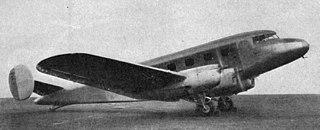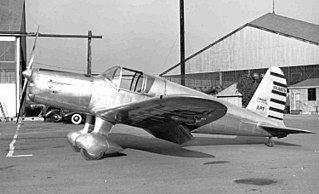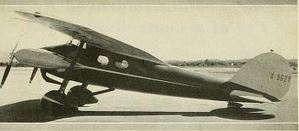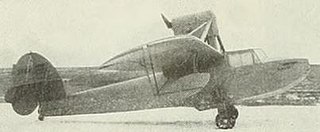
The Blohm & Voss BV 138Seedrache, but nicknamed Der Fliegende Holzschuh was a World War II German trimotor flying boat that served as the Luftwaffe's main seaborne long-range maritime patrol and naval reconnaissance aircraft.

The Dornier Do 12 Libelle III was the third of a line of small German flying boats of the 1930s. It started with the Dornier A Libelle I and the Dornier A Libelle II, though the Do 12 was not a continuation, but an entirely new aircraft.

The Focke-Wulf Fw 191 was a prototype German bomber of World War II, as the Focke-Wulf firm's entry for the Bomber B advanced medium bomber design competition. Two versions were intended to be produced, a twin-engine version using the Junkers Jumo 222 engine and a four-engine variant which was to have used the smaller Daimler-Benz DB 605 engine. The project was eventually abandoned due to technical difficulties with the engines.

The American Champion 8KCAB Decathlon and Super Decathlon are two-seat fixed conventional gear light airplanes designed for flight training and personal use and capable of sustaining aerobatic stresses between +6g and −5g. The Decathlon entered production in the United States in 1970 as a more powerful and stronger complement to the American Champion Citabria line of aircraft.

The PZL.38 Wilk (wolf) (PZL-38) was a Polish fighter-bomber developed and manufactured by PZL state factory in 1937.

The Ranger V-770 was an American air-cooled inverted V-12 aircraft engine developed by the Ranger Aircraft Engine Division of the Fairchild Engine & Aircraft Corporation in the early 1930s.

The Bellanca YO-50 was a United States prototype observation aircraft, built for the United States Army in 1940. Typical for aircraft of its type, it was a high-wing braced monoplane with fixed tailwheel undercarriage and extensive cabin glazing. Its inverted "V" engine made it resemble its German equivalent, the Fieseler Storch.

The Bach Air Yacht was a trimotor airliner produced in the United States in the 1920s. Typical of its day, it was a high-wing braced monoplane, with fixed tailwheel undercarriage. Unusual for airliners of the late 1920s,, the Air Yachts were constructed almost entirely of wood with steel fittings, undercarriage and struts. Different models were powered by varying combinations of Wright, Ryan-Siemens, Kinner, Comet, and Pratt & Whitney engines, a large engine in the nose of the aircraft and two smaller "helpers" under the wings in nacelles supported by struts. As with so many aircraft companies of the late 1920s the Bach Aircraft Company succumbed to the Great Depression, thus further development of the Air Yacht was abandoned after the 3-CT-9.

The Siebel Fh 104 Hallore was a small German twin-engined transport, communications and liaison aircraft built by Siebel.

The Potez 661 was a four-engined metal low-wing monoplane airliner developed in France just before World War II. The single example flew with Air Afrique on French colonial routes.

The Thomas-Morse MB-4 was a prototype American mailplane of the 1920s. It was of unusual design, being a biplane with twin fuselages housing the crew of two and a central nacelle which carried the aircraft's twin engines in a push-pull configuration.

The P.Z.L. 27 was a prototype airliner/mail plane designed by Zbysław Ciołkosz and constructed at P.Z.L. in 1933.

The Aeronca K series, Aeronca Chief, Aeronca Super Chief, Aeronca Tandem, Aeronca Scout, Aeronca Sea Scout, Aeronca Champion and Aeronca Defender were a family of American high-winged light touring aircraft, designed and built starting in the late 1930s by Aeronca Aircraft.

The Waterman Arrowbile was a tailless, two-seat, single-engine, pusher configuration roadable aircraft built in the US in the late 1930s. One of the first of its kind, it flew safely but generated little customer interest, and only five were produced.
The Lambert Twin Monocoach was a light, twin-engined U.S. aircraft, designed to carry three or four passengers. Initially it was fitted with economical, low-powered engines but even given a large increase of power it failed to attract customers.

The Aeroneer 1-B is an all-metal light aircraft built in the United States in 1936. It did not reach production, despite an attempt to interest the USAAC in it as a trainer, but it appeared in three Hollywood films.

The LWF model H Owl was a large American twin-boom trimotor biplane designed and built by LWF Engineering as a mail plane in 1920, but after being rejected for that role, the single prototype was sold to the United States Army Air Service for evaluation as a bomber but failed to secure any orders.

The Ogden Osprey was a three engine, high wing monoplane airliner which seated six. Designed in the United States and first flown in the spring of 1930 or earlier, six were built and some used commercially before Ogden Aeronautical ceased trading in the Great Depression.

The Alcor Duo-4 was a high wing cabin aircraft, unusually powered by a pair of four cylinder straight engines mounted horizontally either side of the nose. After an accident it was rebuilt with six cylinder engines, becoming the Alcor Duo-6. The name Alcor derived from Allan Lockheed Corporation.

The Argonaut Pirate was a 1930s, U.S., three place, single-engined pusher configuration amphibious aircraft. Only two were built.



















